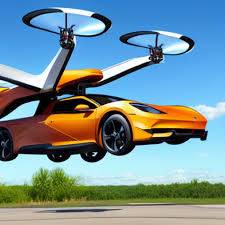Imagine a world where commuting is no longer limited to crowded highways or lengthy train rides. A world where you can soar through the skies in a sleek and futuristic vehicle, avoiding traffic jams and reaching your destination in a fraction of the time. This may sound like science fiction, but the reality of flying cars is closer than ever before. With advancements in technology and innovation, the concept of flying cars is rapidly gaining traction and generating excitement among the masses. In this article, we will delve into the potential of futuristic flying cars and explore how they could revolutionize transportation and transform the way we travel.
The idea of flying cars has been around for decades, but recent breakthroughs in electric propulsion, autonomous systems, and materials science have brought it closer to reality. Companies like Uber, Boeing, Airbus, and numerous startups are actively working on developing flying cars that could reshape our transportation landscape. These vehicles, often referred to as Vertical Takeoff and Landing (VTOL) aircraft, are designed to take off and land vertically, eliminating the need for runways or airports. They can transition from hovering like a helicopter to flying like an airplane, offering unparalleled mobility and flexibility.
One of the most significant advantages of flying cars is their potential to reduce traffic congestion in urban areas. Traffic jams are a persistent problem in many major cities worldwide, resulting in wasted time, increased fuel consumption, and heightened emissions. Flying cars could provide an alternative mode of transportation, bypassing congested roads and reaching destinations faster. Commuters could fly over traffic, saving precious time and avoiding the stress of being stuck in gridlock.
Another key aspect of flying cars is their potential to enhance accessibility to remote areas. Traditional transportation infrastructure, such as roads and bridges, can be expensive and challenging to build in rugged terrains or across bodies of water. Flying cars could overcome these obstacles by offering a flexible mode of transportation that can bypass geographical barriers. They could provide a lifeline for people in remote communities, enabling them to access essential services such as healthcare, education, and economic opportunities.
Furthermore, flying cars could have a transformative impact on industries such as logistics and transportation of goods. Currently, transporting goods over long distances often requires extensive road or rail networks, which can be time-consuming and expensive. Flying cars could offer a more efficient and cost-effective solution for transporting goods, particularly in areas with inadequate infrastructure. They could revolutionize the way we think about supply chains and logistics, making deliveries faster, more reliable, and environmentally friendly.
Safety and sustainability are critical considerations in the development of flying cars. Companies are investing heavily in autonomous systems to ensure safe and reliable operation. These vehicles would be equipped with advanced sensors, communication systems, and redundant controls to mitigate risks and ensure passenger safety. Additionally, many companies are exploring electric propulsion systems to reduce emissions and make flying cars more environmentally friendly.
However, there are also challenges and concerns associated with the development of flying cars. Regulatory frameworks, air traffic management, and public acceptance are among the issues that need to be addressed. Ensuring proper certification and regulation of flying cars will be crucial to guaranteeing their safe operation in the skies. Public perception and acceptance will also play a significant role in the adoption of flying cars as a viable mode of transportation.
In conclusion, the concept of futuristic flying cars holds immense potential to revolutionize transportation and transform the way we travel. With advancements in technology, we are closer than ever to making flying cars a reality. These vehicles could alleviate traffic congestion, enhance accessibility, transform logistics and supply chains, and provide a more sustainable mode of transportation. However, there are also challenges that need to be overcome, including regulatory frameworks, air traffic management, and public acceptance. As we continue to push the boundaries of innovation, the


